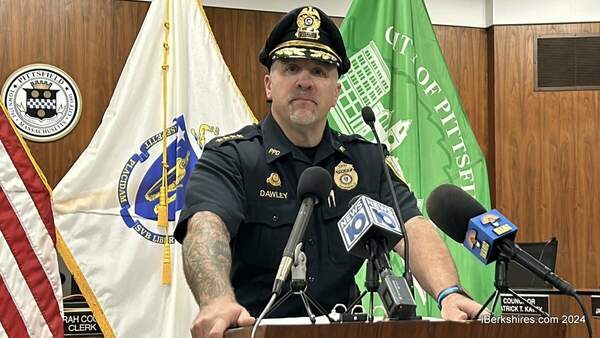



Pittsfield Sees 2nd Ashuwillticook Rail Trail Extension

PITTSFIELD, Mass. — The Ashuwillticook Rail Trail now extends a half-mile farther into Pittsfield, literally paving the way for infrastructure through the downtown and beyond.
Local and state officials beckoned the first wave of pedestrians on the new leg with a ribbon cutting Thursday morning. The trail currently is more than 14 miles long and connects Lime Street in Adams to Merrill Road.
"Outdoor recreation is a vital economy not only here in Pittsfield but in the Berkshires. Pittsfield is always looking for ways to provide more opportunities for both residents and visitors to enjoy the natural environment that we have in the Berkshires. I must say that I'm biased towards Pittsfield as we have the best of both worlds," Mayor Peter Marchetti said.
"We have an active community with a vibrant downtown within a few minutes of captivating natural landscapes. In addition to the rail trail, Pittsfield is fortunate to be home to two beautiful lakes, the state forest, 29 parks, and hundreds of acres of open space and conservation areas. These resources are significant assets that we must protect so we can continue to enjoy them in the years ahead."
Parks, Open Space, and Natural Resource Program Manager James McGrath held up a copy of the city's Bike and Pedestrian Study done nearly 20 years ago. It articulated the construction of a rail trail to this point.
"As a planner, we all know that sometimes things take a long time to come to fruition but here we are today. We've realized this vision, and it is a result of a lot of hard work and advocacy from folks and a lot of the friendly faces that we see here in the audience today," he said.
"But you know, with each section that we construct, we're getting closer to realizing our vision for a true Berkshire bike path. One that connects Vermont with Connecticut and of course, having the section through Pittsfield is important in making that connection and realizing that connection."
The city's connection began in 2022 when a completed 1.5-mile section connected Crane Avenue to the Lanesborough town line. Construction on this latest leg began one year ago and includes a new 11-space parking lot accompanied by a pedestrian hybrid beacon signal at the entrance.
A small garden on the side of the path was dedicated to Pittsfield resident John Yuill, who was a long-standing member of the Berkshire Bike Path Council and assisted with future path planning for the Ashuwillticook Rail Trail.
"John was a founding member of the Berkshire Bike Path Council, serving for 25 years. He shared his computer skills, maintained our membership lists, and sent out alerts and newsletters. He was my sounding board who kept me positive in the face of bike path resistors," council President Marjorie Cohan said.
"… We think about him often. John built a trail for the next generation, knowing that he might never see a completed trail from Vermont to Connecticut but he sure got us started and he still provides the spirit to keep us going. This garden will remind all of John Yuill's many contributions to the cycling in the Berkshires."
Completed by the Massachusetts Department of Transportation, the city's second extension cost $2.2 million, 80 percent paid by the Federal Highway Administration and 20 percent funded by the state.
MassDOT Undersecretary Hayes Morrison said that when open space projects are unveiled "there is just never a frown in the crowd." She reported that future segments in Adams and Pittsfield are also funded for construction by 2028 and the trail will be extended into North Adams and downtown Pittsfield.
"The ultimate goal is for 25 miles of completely off-road trail network from Williamstown to Pittsfield, linking many of the Berkshires' largest population centers," Morrison said.
"Though I've also heard you loud and clear that you really want to go to the borders of Vermont and down, too, we hear that too so maybe more than 25 miles. This day is about joy and creating new memories of the latest addition to this rail trail."
(Williamstown's isolated 2.4-mile Mohican Recreational Path ends about 1.5 miles from the Vermont border.)
DOT Highway Administrator Jonathan Gulliver seconded her comment, explaining that the best crowds are at trail openings "and that really speaks to the kind of partnership and advocacy that everybody here always provides whenever we try to get one of these projects off the ground."
"These are not easy projects to get done. As all of you know, every segment that we do on a rail trail is a success and it takes a lot of work to get it done," he said.
"This is a relatively small segment but it's a very strategic one, again, but it's going to enable a lot more into the future. A lot more transportation connections, a lot more opportunities for the communities in which these trails live."
Gulliver said the state is always pleased to provide funding and partnerships with these positive projects, recognizing the importance of getting people outside.
State Sen. Paul Mark said he was a young state representative in 2011 when he secured some funding through a bond bill for the first Pittsfield extension.
"It took 11 years to get that segment done so it's awesome to be here just two years later continuing the job," he said.
"I'm really excited, I'm really grateful, and again, this is just a great next step in attracting people and making sure that we're showing the entire state of Massachusetts what makes Berkshire County so special and so unique."
Parks Commission Chair Paula Albro pointed out that the trail is used by so many people, including bikers, joggers, rollerbladers, and parents pushing strollers. It is also safe and clean, she said, thanking the city's Parks Department for its upkeep.
"We are so lucky here in Pittsfield. We're blessed, as the mayor said," she added.
"We have open space, we have parks to enjoy, acres and acres of parks for outside recreational use and for all ages, and that's what I really love about it. This money was well spent."
Cohan said this path is one of the most used facilities in the city by locals and visitors alike.
"The beauty of this trail, the lakes, the mountains, the amenities, including the bathrooms, the parking, the smooth pavement, and the consistent maintenance as well as its accessibility, make this one of the best bike paths in the state," she said.
"This is not just a bike path, it is a linear park where people enjoy nature, meet friends, and engage in healthy activities. It is a peaceful retreat from the chaos in the rest of the world so you might want to stand on it today."
As a part of this new extension, MassDOT installed a pedestrian hybrid beacon (HAWK) signal across Merrill Road at the entrance to the parking lot. This traffic control device is designed to stop vehicles to allow pedestrians to cross safely.
With this new signal, the city shares what drivers should do while approaching this crossing:
• Dark Signal/No Lights: Drivers may proceed through the crossing as usual until the signal
is activated by a pedestrian.
• Flashing Yellow Lights: Drivers should prepare to slow down as pedestrians have
activated the crosswalk push button.
• Solid Yellow Lights: Drivers should slow down and prepare to stop.
• Solid Red Lights: Drivers must completely stop and let pedestrians cross.
• Flashing Red Lights: After stopping, drivers may proceed once the crosswalk is clear.
Tags: Ashuwillticook Rail Trail, ribbon cutting,















